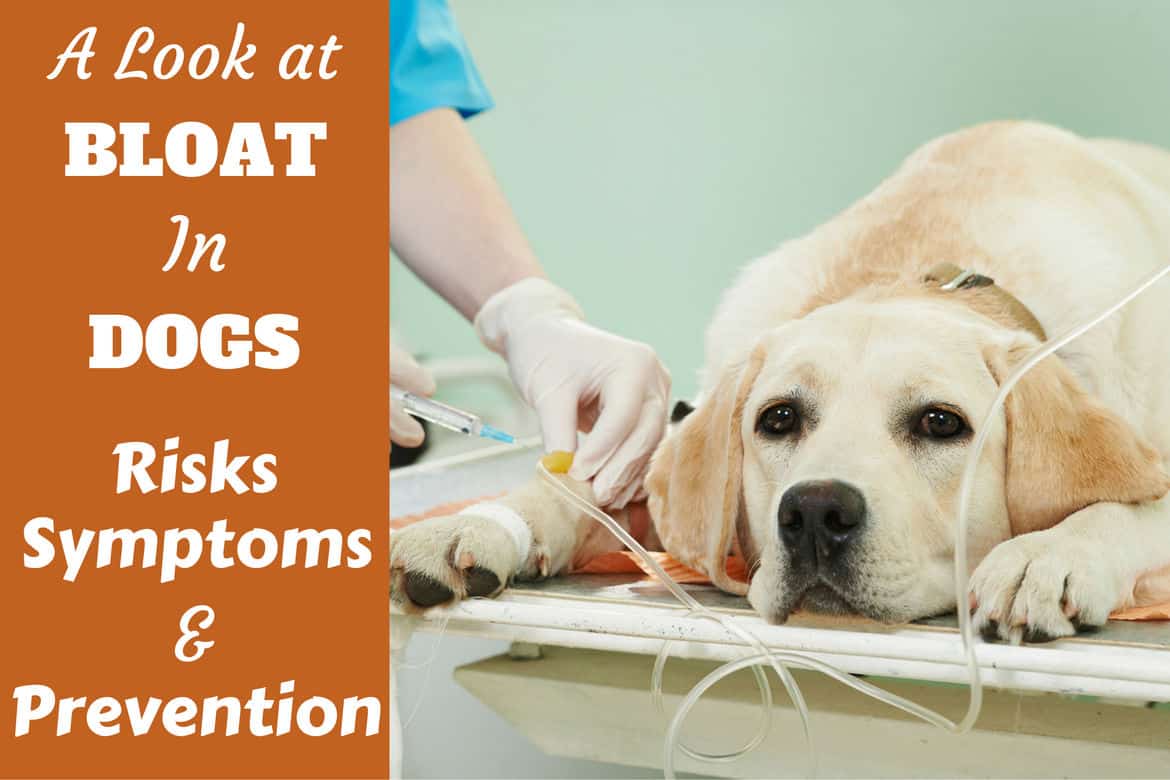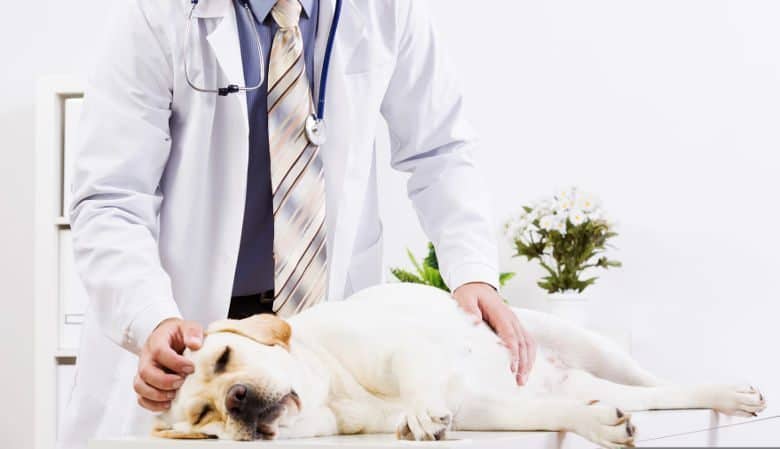This post may contain affiliate links. We may earn money or products from the companies mentioned in this post.

Here at Labrador Training HQ, we’ve recommended plenty of dog foods, but we haven’t yet touched on the risks of bloat when feeding your dog, so that’s what we’re going to discuss today.
Unfortunately, Labradors – along with all other deep-chested dogs – have a greater risk of developing bloat than other breeds, so every Lab owner should bone up on this topic.
Bloat is a serious problem that can prove fatal, especially if no steps are taken early on. That’s why it’s vital you know what you can do to help prevent it and how to spot the symptoms so you can take immediate action if it seems your Lab is affected.
What Is Bloat in Dogs?
The correct medical term for the condition commonly known as bloat is gastric dilation-volvus, or GDV. However, it is also sometimes referred to as gastric torsion, stomach torsion or a twisted stomach.
According to PetEducation.com, GDV is technically two conditions, or there are two parts to the same condition:
- The first is the gastric dilation, which is when the stomach expands
- The second is the volvus, where the stomach twists causing an obstruction.
During the dilation phase, the stomach fills up with air putting pressure on the organs around it and the dog’s diaphragm, making it hard for the dog to breathe. It also compresses veins in the abdomen, making it more difficult for blood to return to the heart.
When the stomach is filled with air and in this dilated state, it can much more easily twist. This is the volvus, or torsion, part of GDV. When this occurs, the dog’s whole blood supply is compromised, and their condition will deteriorate quickly.
Not every dog who develops gastric dilation will progress to the volvus stage. However, every dog who suffers from volvus does so as a result of gastric dilation.
Symptoms and Signs of Bloat in Dogs
Bloat has a range of symptoms, but remember; your dog may not display each and every one of these. Even if they display just a single one of these symptoms, it’s worth getting them checked out ASAP.
During the dilation phase, according to WebMD, your dog may:
- Have visibly distended stomach (look bloated – hence the name.)
- Look anxious
- Drool
- Pace
- Look at their stomach
- Try to vomit, but have nothing come up
Then, as the condition worsens, and the stomach is starting to twist, they may:
- Be short of breath
- Have pale gums
- Have a rapid heartbeat
- Feel weak
- Collapse
Sadly, even with treatment, as many as 25 to 33 percent of dogs who develop GVD die. The sooner you get your dog to the vet, the better, because the prognosis is much better if it’s caught before the stomach twists.
Even if you’re a little concerned your dog might possibly have bloat, don’t wait around and see if they start to show any other symptoms, take them to the veterinary clinic right away. An unnecessary vet bill is much better than losing your four-legged friend.
What Causes Bloat In Dogs?

Before we start with this section, it’s worth noting that in many cases it’s unclear exactly what causes bloat in dogs. Vets and other experts have theories, but there’s no certain answer.
If you look at the research that’s been carried out, there seem to be certain unavoidable risk factors, such as breed and age, but also some potential causes that can be avoided.
According to vin.com, one of the most thorough, long-range studies on bloat was carried out by Dr. Larry Glickman from the Purdue University School of Veterinary Medicine.
This study followed almost 2,000 dogs over five years, and found a correlation between increased likelihood of getting bloat and the following factors:
- Chest size and shape: Dogs with deep and narrow chests have the highest chance of developing bloat.
- Weight: Slimmer dogs have more chance of suffering gastric torsion than overweight dogs, possibly because fat takes up room in the abdominal cavity, making it harder for the stomach to twist.
- Age: In larger breeds, dogs over five are 20 percent more likely to develop the condition.
- Genetics: Bloat may have a genetic factor, as dogs who had a first degree relative who had contracted bloat were 63 percent more likely to get it themselves.
- Eating speed: Dogs who eat their food quickly have a 15 percent higher chance of developing GDV compared to slower eaters.
- Eating position: Although previous thoughts suggested the opposite, raised food and water bowls actually increase the risk of a dog getting bloat, by as much as 110 percent.
- Temperament: Dogs whose owners described them as being fearful, anxious or aggressive were more likely to get bloat than those who were described as having a happy temperament.
- Stress: Dogs who have recently been through a stressful event, such as a move or a stay in kennels, seem to be more likely to contract bloat.
- Sex: A higher percentage of males suffer from bloat compared to females.
- Dry food: Dogs who eat just dry kibble are more likely to bloat than those on a wet food diet or those who eat wet food or table food mixed in with their kibble.
- Meal size: Eating a single, large meal a day increases the risk of bloating, compared to dogs who eat two or three smaller meals a day.
There are some popular theories about why dogs bloat which the above study couldn’t substantiate. It could be that these theories are incorrect, but it’s important to remember that this is just one study, so it’s not fully conclusive.
Commonly believed risk factors which couldn’t be proved include:
- Dogs being exercised soon before or after eating.
- Drinking too much water with their food.
- The brand of dog food that’s consumed.
How Is Bloat Treated?
There are several ways of treating bloat, depending on the progression of the dog’s condition. Before we discuss this though, we want to make one thing very clear;
Do not attempt to treat your dog’s bloat at home.
GDV has a high fatality rate and will almost certainly result in death if untreated. Even if it’s the middle of the night, go straight to an out-of-hours veterinary clinic. Don’t wait until the morning to sort it out.
The American College of Veterinary Surgeons explains a few of the treatment options:
If the bloat has gone far enough that your dog has gone into shock, the first step will be to stabilize your pet, which involves oxygen therapy and administering IV fluids.
For dogs who have seriously dilated stomachs, but no torsion as yet, there are two main options:
- One is to place a tube down the dog’s throat and into the stomach. This should relieve the pressure. Sometimes water is also used to wash any remnants of food from the stomach.
- In some cases, for instance if the tube won’t do down, a long needle is inserted into the dog’s stomach from the outside to release the trapped air.
If the dog has suffered a full bout of GDV, meaning their stomach has twisted, it’s extremely likely they will require emergency surgery to fully de-rotate the stomach and re-establish normal blood flow.
Depending on the damage suffered, the dog may have to have part of their stomach and/or their spleen removed.
The veterinary surgeon will also permanently fix the stomach to the abdominal wall, so that if the dog experiences gastric dilation again, their stomach won’t be able to twist.
How to Prevent Bloat in Dogs?
Of course, the ideal situation is your dog never contracting bloat at all, so owners should do everything they can to help prevent it.
As mentioned above, the exact reasons for dogs bloating are sometimes mysterious, and although experts have found correlations, there’s not much in the way of hard evidence.
In the interest of being safe, rather than sorry, we’d recommend following any and all bloat-preventing advice that you can.
According to experts, such as those at the ASPCA, to help prevent bloat, you should:
- Feed your dog two or three small meals each day, rather than one big one.
- Include some canned food in your dog’s diet, not feed 100 percent dried kibble.
- Put food bowls on the floor, rather than using a raised feeder, unless otherwise advised by your vet.
- Avoid feeding your dog too soon before or after exercising.
- Feed dogs separately if you have more than one, as they should eat more slowly if they don’t feel they’re competing for food.
- Use a slow feeder bowl if you have a dog who bolts their food.
- Encourage normal water consumption with meals.
What You Should Take Away
Although Labradors aren’t one of the highest risk breeds for bloat out there, they still have a higher than average chance of developing this condition, so it’s important to be vigilant.
Limit the risk of bloating by taking the preventative steps above, but always be on the lookout for symptoms and take your dog to the vet at the first sign of any trouble.
Disclaimer
All content on this site is provided for informational and entertainment purposes only. It is not intended to be nor can it be considered actionable professional advice. It must not be used as an alternative for seeking professional advice from a veterinarian or other certified professional.
LabradorTrainingHQ.com assumes no responsibility or liability for the use or misuse of what’s written on this site. Please consult a professional before taking any course of action with any medical, health or behavioral related issue.
Top Picks For Our Dogs
- BEST PUPPY TOY
We Like: Calmeroos Puppy Toy w/ Heartbeat and Heat Packs - Perfect for new puppies. Helps ease anxiety in their new home. - BEST DOG CHEW
We Like: Bones & Chews Bully Sticks - All of our puppies love to bite, nip, and chew. We love using Bully Sticks to help divert these unwanted behaviors. - BEST DOG TREATS
We Like: Crazy Dog Train Me Treats - One of our favorite treats for training our service dog puppies. - BEST FRESH DOG FOOD
We Like: The Farmer's Dog - A couple months ago we started feeding Raven fresh dog food and she loves it! Get 50% off your first order of The Farmer's Dog.
For a list of all the supplies we get for our new service dog puppies check out our New Puppy Checklist on the PuppyInTraining.com blog.
1 comment
Thank you so much for taking the time to thoroughly explain this important on Labrador Retriever bloat. I had an 11 year old huge Chocolate Labrador Retriever (big chested) who developed bloat. At the time I never head of it. After wondering what was happening and making several calls, I took her to the Animal Emergency Hospital (NY). After 5 hours later, she was operated and saved!! Unfortunately, my 6 year old medium size Chocolate Labrador Retriever (not big chested) did not make it. Strangely, we took her to the Vet on a ‘routine’ visit/check-up. Prior to the visit to the Vet, she was happy and playful. As soon as we entered the Vet Office, she was very shaken and scared. The Vet never tested her yet he administered a Depo-Medrol for infection since we mentioned she had mild shortness of breath (which had been going on for many months). She died 15 minutes after that vaccine! It was later determined she had Bloat. But I strongly believe that vaccine caused her panic/stress to bring on the Bloat. It breaks my heart that she was only 6 years old :(